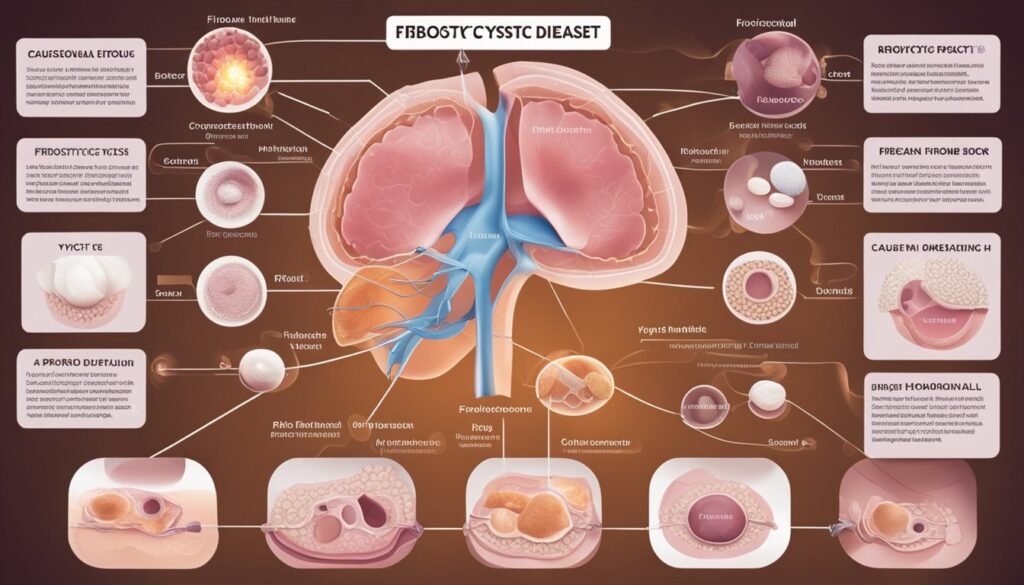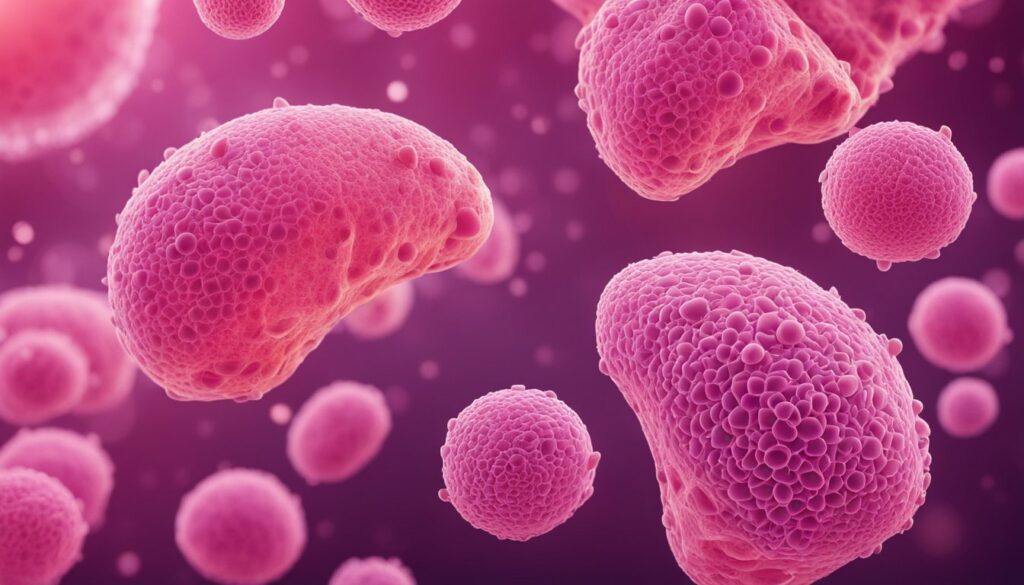Fibrocystic breast disease encompasses a range of conditions affecting the breast tissue, making it feel lumpy or rope-like. Often considered a benign condition, it’s not uncommon for you to experience these changes, especially if you are in your premenopausal years. The composition of your breast tissue can fluctuate with your menstrual cycle, leading to nodular or glandular formations that are typically more prominent and sensitive during specific times of the month.

The role of hormones such as estrogen and progesterone is significant in the presentation of fibrocystic breast disease. Your hormonal fluctuations can influence the texture and feel of the breast tissue, which sometimes results in noncancerous lumps that can vary in size. While the symptoms can be concerning, understanding that these changes are part of a nonmalignant condition might offer some reassurance.
If you’re experiencing tender or lumpy breasts, it could be related to these fibrocystic changes. However, it’s essential to distinguish between common fibrocystic symptoms and those that may warrant a closer examination. Regular self-checks and understanding your body’s patterns are crucial in managing your breast health. If you notice new or unusual changes in your breast tissue, it’s advisable to consult with a healthcare provider to rule out any serious conditions.
Understanding Fibrocystic Breast Disease

Fibrocystic breast disease is characterized by the presence of lumpy, glandular breast tissue and often accompanies discomfort. It is a common, benign condition associated with hormonal changes in the body.
Definition and Etiology
Fibrocystic breast disease, often referred to as fibrocystic changes or benign breast disease, is a noncancerous condition where your breast tissue feels irregular and sometimes causes pain. The etiology is linked to hormonal fluctuations, particularly levels of estrogen, which can affect the epithelial cells in the breast.
Signs and Symptoms
The symptoms you may experience with fibrocystic breast disease include:
- Breast pain or tenderness
- Lumpiness or thick areas within the breast tissue
- Cysts, which are fluid-filled sacs
- Nipple discharge, which may be clear or slightly colored but typically not bloody
These symptoms often intensify during the premenstrual phase due to increased estrogen levels and tend to alleviate after the menstrual period.
Diagnosis and Imaging
To diagnose fibrocystic breast disease, a healthcare provider will perform a breast exam to assess for anomalies. Imaging tests, such as a mammogram or ultrasound, can help distinguish between fibrocystic changes and other conditions. In some cases, if there’s significant concern or if a lump feels distinctly unusual, a biopsy may be conducted to rule out cancer. Mammography is a crucial tool in this process, offering a detailed image of the fibrous and glandular tissues.
Management and Treatment

Effective management and treatment of fibrocystic breast disease focus on alleviating symptoms and monitoring breast changes. Treatment is often personalized, as what works for one individual may not work for another. The aim is typically to reduce discomfort and assure that any breast changes do not signify conditions such as cancer.
Lifestyle and Self-Care
In managing fibrocystic breast conditions, your self-care is paramount. Adjusting dietary choices, such as reducing caffeine intake and adopting a low-fat diet, could alleviate symptoms. Heat application or ice packs can offer relief from pain or discomfort. Wearing a supportive bra may also provide comfort, especially during physical activity.
- Heat and Ice: Apply warm compresses or cold packs to ease tenderness.
- Dietary Adjustments: Consider lowering caffeine consumption and fats in your diet.
Regular breast self-examinations are crucial for monitoring any breast changes and should be a part of your self-care routine.
Medical Interventions
If lifestyle modifications and self-care measures don’t sufficiently control your discomfort, medical interventions are available. Over-the-counter pain relievers like acetaminophen and ibuprofen can be effective for pain management. In certain cases, your healthcare provider may propose hormone therapy or birth control pills to regulate hormones and reduce symptoms. Tamoxifen, a medication more commonly used for breast cancer, has also been helpful in some cases of severe pain associated with fibrocystic breasts.
- OTC Pain Relievers: Utilize medications like acetaminophen or ibuprofen as needed for pain.
- Hormonal Therapies: Birth control pills or hormone therapy might help balance hormone levels.
Surgical Procedures
Surgery is rarely required for fibrocystic breast disease. However, if there’s persistent and unclear discharge or an area in the breast that raises concern, a needle or core needle biopsy might be conducted to rule out cancer. Surgical removal of lumps may occasionally be recommended if they cause significant discomfort or complicate the interpretation of breast changes.
- Biopsy Procedures: To evaluate unusual findings, a needle biopsy may be necessary.
- Lump Removal: In instances of extreme discomfort or diagnostic uncertainty, surgery might be considered.
Remember, after menopause, many women experience a natural decrease in fibrocystic changes. However, you should continue to monitor your breast health and consult your doctor if you notice any concerning changes.
Frequently Asked Questions

Understanding the nuances of fibrocystic breast disease can help you manage your symptoms more effectively and navigate your treatment options with confidence.
What self-care strategies are effective for managing symptoms of fibrocystic breast condition?
You might find relief by wearing a supportive bra and applying warm or cold compresses to your breasts. Over-the-counter pain relievers may also be helpful in managing the discomfort associated with fibrocystic breasts.
Are there specific dietary recommendations to alleviate fibrocystic breast discomfort?
Reducing caffeine and lowering the intake of fat in your diet could potentially ease breast pain. Staying well-hydrated and maintaining a balanced diet rich in fruits, vegetables, and whole grains may also be beneficial.
What medications are commonly prescribed for treating fibrocystic breast disease?
For persistent symptoms, your healthcare provider may recommend oral contraceptives to regulate hormone levels or prescribe medications like danazol and tamoxifen, though these are less common due to potential side effects.
How is an ultrasound used in the diagnosis and management of fibrocystic breast disease?
An ultrasound is a non-invasive imaging test that helps distinguish solid lumps from fluid-filled cysts in your breasts and guides the management of fibrocystic changes by providing detailed images of the breast tissues.
Is there a relationship between vitamin E intake and the mitigation of fibrocystic breast disease symptoms?
Some studies suggest that vitamin E supplements could reduce breast pain associated with fibrocystic changes, but it’s essential to consult with your doctor before adding any supplements to your regimen.
Is it possible for fibrocystic breast changes to increase the risk of developing breast cancer?
While fibrocystic breast changes are mostly benign and not directly linked to an increased risk of breast cancer, having complex fibrocystic changes may make it more challenging to identify potential malignancies during breast examinations. Regular screenings are important for early detection.